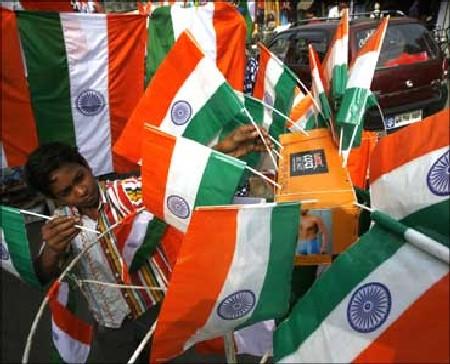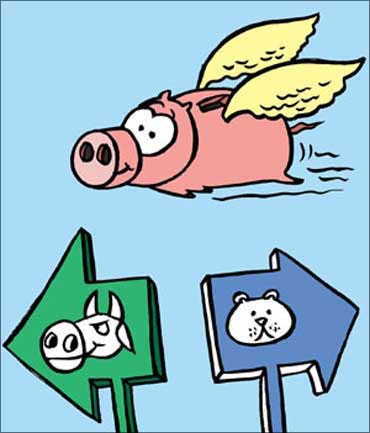 | « Back to article | Print this article |
Will global investors bet big on India again?
The year 2011 was a really nasty one for the Indian equity markets, with the Nifty index down about 25 per cent, mid-cap indices down nearly 35 per cent -- and in dollar terms India was the worst-performing market of 2011, down about 37 per cent.
Everything that could have gone wrong in 2011 seemingly did. Investors began the year expecting GDP growth to clock near nine per #162 it will be near seven per cent.
Inflation was seen as a short-term problem, something the Reserve Bank of India (RBI) could tackle with a couple of rate hikes; instead it was very sticky, flirting with double digits, and the RBI was forced to be very aggressive and lead the world in monetary tightening.
Investors began the year expecting 15 to 20 per cent earnings growth for the Sensex; but will get, at best, five to eight per cent, with the cycle of continuous earnings downgrades still in motion.
Click NEXT to read more...
Will global investors bet big on India again?
Many investors had assumed rupee appreciation in their internal rate-of-return calculations; but were hit by 18-per cent rupee depreciation, totally destroying any hopes of making a return out of any asset class in India.
But by far the most disappointing aspect of 2011 was the total breakdown in investor and corporate confidence. There was a strong sense of policy paralysis, and for the first time even seasoned long-term India bulls began to question their investment thesis.
A growth rate of nine per cent was no longer taken as a birthright, and investors -- worried about the left-of-centre orientation of most policy decisions -- began to openly question where India was going.
Having said all this, what about 2012? Can India mount a smart recovery and get back on the radar of global investors?
Click NEXT to read more...
Will global investors bet big on India again?
Trying to form a bullish view on India is clearly a contrarian effort given overall sentiment. I have not seen sentiment this bad on India for years. The country's weightage in the MSCI Emerging Markets index is down to about seven per #162 most investor surveys show.
India to be a consensus short/underweight; and investor interest in allocating new capital to India funds is non-existent. Trading volumes in the cash markets are at a seven-year low.
Money raised from Initial Public Offerings is at an eight-year low. Equities have massively underperformed all other asset classes in India over the last five years, and thus retail investors are happily lapping up double-digit yields in fixed-income products, allocating next to nothing to equities.
In terms of valuations, while markets are trading cheaper than their long-term averages, this in no way feels like the first quarter of 2009, when even high-quality franchises were available cheap.
Click NEXT to read more...
Will global investors bet big on India again?
Mid-caps and stocks with economic sensitivity have been hammered, and are cheap if you are willing to look at normalised earnings power -- but defensive high-quality consumer businesses are trading at all-time high valuations. If you have a quality bias, then you need a further 10 per cent correction for things to get really interesting.
In terms of earnings, my sense is that India is near the end of the downgrade cycle. Investors do not expect more than eight to 10 per cent earnings growth for 2012-2013 - which looks do-able, and in fact, to my mind, is likely to be beaten.
Interest rates are also clearly headed down, but this is already in everyone's expectations. The surprise here could be in the timing and pace of declines.
Around flows, with less than a billion dollars leaving India in 2011, it is debatable as to what this implies. Does this imply that a lot more capital can flee, marking the final capitulation? Or does it prove how sticky this capital is?
Click NEXT to read more...
Will global investors bet big on India again?
While the above is well known, the real difference between the bull and the bear case in 2012 depends on the government. Will it bite the bullet and take decisions?
The bulls argue that India has seen the worst of policy inaction, and the government will come out with all guns blazing in the Union Budget, which will be presented (thankfully) after the UP elections.
Signs of activity are already visible, they argue -- 100 per cent foreign direct investment in single-brand retail, national manufacturing policy, movement on environmental issues, National Highway Authority of India activity and so on. Given how low expectations are, the government will be able to surprise.
Independent of the RBI cutting rates, the government can kick-start the investment cycle by clearing regulatory and policy bottlenecks.
Click NEXT to read more...
Will global investors bet big on India again?
Any improvement in confidence will trigger a virtuous cycle, projects will start moving, the RBI will be cutting rates, companies will recapitalise and, as we lap easy comparisons for both earnings and GDP in the second half of 2012-13, India will look like it is accelerating again.
As the economy re-accelerates, both earnings and multiples will be upgraded. The bulls argue that it is unreasonable to assume that the government will continue doing nothing if it has any desire to be re-elected in 2014. The UP elections can be a game-changer in strengthening the hands of the Congress in Delhi.
The bears assume that the current status quo continues and this government is unable to achieve much, given its internal and coalition constraints. It is unable to stand up to or resist any organised interest group, and take tough decisions.
In its desperation to win votes, populism will be front and centre in every government move. We bump along on this six or seven per cent growth trajectory, with no improvement in either business or investor confidence.
Click NEXT to read more...
Will global investors bet big on India again?
In this scenario, we have the twin deficits (current account and fiscal) under stress, and the further build-up of imbalances. Crisis situations will erupt in the power, coal, rail and banking sectors.
Markets will continue to de-rate, lose global relevance, and investors will write off the country till 2014. Even the RBI cutting rates will not be enough to trigger a capital expenditure cycle, as policy constraints will continue to hamper investment.
Markets will continue correcting from both time and price perspectives. All this is independent of the continuing global uncertainty.
Click NEXT to read more...
Will global investors bet big on India again?
A bullish view today is really a bet on better governance and increased policy coherence. One has to accept that at the moment any such optimism is based more on hope than hard evidence.
It is hard to believe that we can just throw away all the hard-won gains of the last decade. Better economic sense has to prevail, or so one hopes.
Have we so truly lost the plot that short-term populism and political grudges will be allowed to sabotage our long-term future? Have the lessons of the Bihar and Gujarat elections already been forgotten, in that governance and not just populism can win elections?
Click NEXT to read more...
Will global investors bet big on India again?
Investors face a dilemma: if they wait for full clarity on policy, given positioning, markets will go up 15 to 20 per cent very quickly on any positive cues, giving little chance to participate.
But if one tries to be pre-emptive, and bet on better policy traction, that is really based on hope and a feeling that something has to give and India will not implode; it is not backed by any evidence on the ground as of now.
We are setting up a very interesting market dynamic. Sentiment and investor participation are at a low, valuations are within 10 per cent of being very interesting, both the monetary and earnings upgrade cycles are turning in your favour and policy expectations are non-existent. Can the government deliver anything that will enthuse investors?
The author is fund manager and CEO of Amansa Capital.









